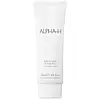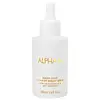What's inside
What's inside
 Key Ingredients
Key Ingredients

 Benefits
Benefits

 Concerns
Concerns

 Ingredients Side-by-side
Ingredients Side-by-side

Water
Skin ConditioningGlycolic Acid
BufferingCaprylic/Capric Triglyceride
MaskingDimethicone
EmollientCetearyl Alcohol
EmollientGlyceryl Stearate
EmollientPEG-100 Stearate
Cyclopentasiloxane
EmollientEuglena Gracilis Extract
Skin ConditioningPotassium Hydroxide
BufferingCeteareth-20
CleansingSodium Carrageenan
Emulsion StabilisingGlycerin
HumectantStearic Acid
CleansingHydrolyzed Wheat Flour
Skin ConditioningPhenoxyethanol
PreservativeMaltodextrin
AbsorbentSimmondsia Chinensis Seed Oil
EmollientDimethicone Crosspolymer
Emulsion StabilisingParfum
MaskingButyrospermum Parkii Butter
Skin ConditioningMangifera Indica Seed Butter
Skin ConditioningPrunus Amygdalus Dulcis Oil
Skin ConditioningRetinol
Skin ConditioningTocopheryl Acetate
AntioxidantVitis Vinifera Seed Oil
EmollientPanthenol
Skin ConditioningTanacetum Annuum Flower Oil
MaskingGluconolactone
Skin ConditioningAllantoin
Skin ConditioningDisodium EDTA
Sodium Benzoate
MaskingAloe Barbadensis Leaf
MaskingCalcium Pantothenate
Xanthan Gum
EmulsifyingCaprylyl Glycol
EmollientProline
Skin ConditioningSerine
MaskingSodium Hyaluronate
HumectantUrea
BufferingMagnesium Lactate
BufferingPapain
Skin ConditioningEthylhexylglycerin
Skin ConditioningCalcium Gluconate
HumectantAlanine
MaskingMagnesium Chloride
Sodium Citrate
BufferingLimonene
PerfumingLinalool
PerfumingWater, Glycolic Acid, Caprylic/Capric Triglyceride, Dimethicone, Cetearyl Alcohol, Glyceryl Stearate, PEG-100 Stearate, Cyclopentasiloxane, Euglena Gracilis Extract, Potassium Hydroxide, Ceteareth-20, Sodium Carrageenan, Glycerin, Stearic Acid, Hydrolyzed Wheat Flour, Phenoxyethanol, Maltodextrin, Simmondsia Chinensis Seed Oil, Dimethicone Crosspolymer, Parfum, Butyrospermum Parkii Butter, Mangifera Indica Seed Butter, Prunus Amygdalus Dulcis Oil, Retinol, Tocopheryl Acetate, Vitis Vinifera Seed Oil, Panthenol, Tanacetum Annuum Flower Oil, Gluconolactone, Allantoin, Disodium EDTA, Sodium Benzoate, Aloe Barbadensis Leaf, Calcium Pantothenate, Xanthan Gum, Caprylyl Glycol, Proline, Serine, Sodium Hyaluronate, Urea, Magnesium Lactate, Papain, Ethylhexylglycerin, Calcium Gluconate, Alanine, Magnesium Chloride, Sodium Citrate, Limonene, Linalool
Water
Skin ConditioningGlycolic Acid 14%
BufferingGlycerin
HumectantButylene Glycol
HumectantPropanediol
SolventDicaprylyl Carbonate
EmollientDimethicone
EmollientPotassium Hydroxide
BufferingCetyl Alcohol
EmollientHydrolyzed Jojoba Esters
Skin ConditioningMethyl Gluceth-20
HumectantSodium Polyacryloyldimethyl Taurate
Emulsion StabilisingTocopherol
AntioxidantHelianthus Annuus Seed Oil
EmollientDimethyl Isosorbide
SolventPhenoxyethanol
PreservativeFerulic Acid
AntimicrobialGlyceryl Stearate
EmollientPEG-100 Stearate
Ammonium Glycyrrhizate
MaskingHibiscus Sabdariffa Flower Extract
Skin ConditioningCaprylyl Glycol
EmollientHydroxypinacolone Retinoate 1%
Skin ConditioningSodium Hyaluronate
HumectantUbiquinone
AntioxidantHippophae Rhamnoides Fruit Extract
Skin ConditioningCodonopsis Lanceolata Extract
AntioxidantEthylhexylglycerin
Skin ConditioningPalmitoyl Tripeptide-5
Skin ConditioningWater, Glycolic Acid 14%, Glycerin, Butylene Glycol, Propanediol, Dicaprylyl Carbonate, Dimethicone, Potassium Hydroxide, Cetyl Alcohol, Hydrolyzed Jojoba Esters, Methyl Gluceth-20, Sodium Polyacryloyldimethyl Taurate, Tocopherol, Helianthus Annuus Seed Oil, Dimethyl Isosorbide, Phenoxyethanol, Ferulic Acid, Glyceryl Stearate, PEG-100 Stearate, Ammonium Glycyrrhizate, Hibiscus Sabdariffa Flower Extract, Caprylyl Glycol, Hydroxypinacolone Retinoate 1%, Sodium Hyaluronate, Ubiquinone, Hippophae Rhamnoides Fruit Extract, Codonopsis Lanceolata Extract, Ethylhexylglycerin, Palmitoyl Tripeptide-5
 Reviews
Reviews

Ingredients Explained
These ingredients are found in both products.
Ingredients higher up in an ingredient list are typically present in a larger amount.
Caprylyl Glycol is a humectant and emollient, meaning it attracts and preserves moisture.
It is a common ingredient in many products, especially those designed to hydrate skin. The primary benefits are retaining moisture, skin softening, and promoting a healthy skin barrier.
Though Caprylyl Glycol is an alcohol derived from fatty acids, it is not the kind that can dry out skin.
This ingredient is also used as a preservative to extend the life of products. It has slight antimicrobial properties.
Learn more about Caprylyl GlycolDimethicone is a type of synthetic silicone created from natural materials such as quartz.
What it does:
Dimethicone comes in different viscosities:
Depending on the viscosity, dimethicone has different properties.
Ingredients lists don't always show which type is used, so we recommend reaching out to the brand if you have questions about the viscosity.
This ingredient is unlikely to cause irritation because it does not get absorbed into skin. However, people with silicone allergies should be careful about using this ingredient.
Note: Dimethicone may contribute to pilling. This is because it is not oil or water soluble, so pilling may occur when layered with products. When mixed with heavy oils in a formula, the outcome is also quite greasy.
Learn more about DimethiconeEthylhexylglycerin (we can't pronounce this either) is commonly used as a preservative and skin softener. It is derived from glyceryl.
You might see Ethylhexylglycerin often paired with other preservatives such as phenoxyethanol. Ethylhexylglycerin has been found to increase the effectiveness of these other preservatives.
Glycerin is already naturally found in your skin. It helps moisturize and protect your skin.
A study from 2016 found glycerin to be more effective as a humectant than AHAs and hyaluronic acid.
As a humectant, it helps the skin stay hydrated by pulling moisture to your skin. The low molecular weight of glycerin allows it to pull moisture into the deeper layers of your skin.
Hydrated skin improves your skin barrier; Your skin barrier helps protect against irritants and bacteria.
Glycerin has also been found to have antimicrobial and antiviral properties. Due to these properties, glycerin is often used in wound and burn treatments.
In cosmetics, glycerin is usually derived from plants such as soybean or palm. However, it can also be sourced from animals, such as tallow or animal fat.
This ingredient is organic, colorless, odorless, and non-toxic.
Glycerin is the name for this ingredient in American English. British English uses Glycerol/Glycerine.
Learn more about GlycerinGlyceryl Stearate is a mix of glycerin and stearic acid.
It is used to stabilize the mixing of water and oil ingredients. By preventing these ingredients from separating, it can help elongate shelf life. It can also help thicken the product's texture.
As an emollient, it helps soften skin and supports barrier-replenishing ingredients.
In cosmetics, Glyceryl Stearate is often made from vegetable oils or synthetically produced.
This ingredient may not be fungal-acne safe
Fun fact: The human body also creates Glyceryl Stearate naturally.
Learn more about Glyceryl StearateGlycolic Acid is arguably the most famous alpha hydroxy acid (AHA) with tons of research backing its benefits.
It is found naturally in sugar cane but the form used in skincare is usually synthetic for purity and stability.
Glycolic acid removes the top layer of dead skin cells to allow newer and fresher ones to emerge.
AHAs work by breaking down the structural “glue” that holds old skin cells in place. When that buildup is gone, your skin can renew itself more efficiently.
Research also shows glycolic acid stimulates collagen production, helping to firm and thicken the skin over time. This is one of its biggest advantages over other AHAs.
Overall, glycolic acid helps with:
Fun fact: Glycolic acid boosts skin hydration by helping it produce molecules that increase hyaluronic acid naturally.
To work best, glycolic acid products should have a pH between 3-4 (that’s where exfoliation is most effective but still gentle on skin).
The pH and concentration of a product are key to its effectiveness:
It is normal to feel a slight stinging sensation when using glycolic acid. This usually fades as your skin adjusts.
Because glycolic acid has the smallest molecular size in the AHA family, it can penetrate deeper, which enhances its effectiveness but also makes it more likely to irritate sensitive skin.
If your skin is very sensitive or prone to rosacea, glycolic acid may be too strong; in that case, try milder options like lactic acid or a PHA instead.
Recent studies suggest glycolic acid might even help protect against UV damage. But don’t skip sunscreen! Freshly exfoliated skin is more sensitive to the sun.
Glycolic acid is a skincare superstar. It smooths, brightens, hydrates, and firms the skin. Unless you’re highly sensitive, it’s well worth adding to your routine.
Read more about some other popular AHA's here:
Learn more about Glycolic AcidPeg-100 Stearate is an emollient and emulsifier. As an emollient, it helps keep skin soft by trapping moisture in. On the other hand, emulsifiers help prevent oil and water from separating in a product.
PEGS are a hydrophilic polyether compound . There are 100 ethylene oxide monomers in Peg-100 Stearate. Peg-100 Stearate is polyethylene glycol ester of stearic acid.
Phenoxyethanol is a preservative that has germicide, antimicrobial, and aromatic properties. Studies show that phenoxyethanol can prevent microbial growth. By itself, it has a scent that is similar to that of a rose.
It's often used in formulations along with Caprylyl Glycol to preserve the shelf life of products.
Potassium hydroxide is commonly known as caustic potash. It is used to fix the pH of a product or as a cleaning agent in soap. In cleansers, it is used for the saponification of oils.
Sapnification is the process of creating fatty acid metal salts from triglycerides and a strong base. During this process, Potassium Hydroxide is used up and is not present in the final product.
Using high concentrations of Potassium Hydroxide have shown to irritate the skin.
Learn more about Potassium HydroxideSodium Hyaluronate is hyaluronic acid's salt form. It is commonly derived from the sodium salt of hyaluronic acid.
Like hyaluronic acid, it is great at holding water and acts as a humectant. This makes it a great skin hydrating ingredient.
Sodium Hyaluronate is naturally occurring in our bodies and is mostly found in eye fluid and joints.
These are some other common types of Hyaluronic Acid:
Learn more about Sodium HyaluronateWater. It's the most common cosmetic ingredient of all. You'll usually see it at the top of ingredient lists, meaning that it makes up the largest part of the product.
So why is it so popular? Water most often acts as a solvent - this means that it helps dissolve other ingredients into the formulation.
You'll also recognize water as that liquid we all need to stay alive. If you see this, drink a glass of water. Stay hydrated!
Learn more about Water